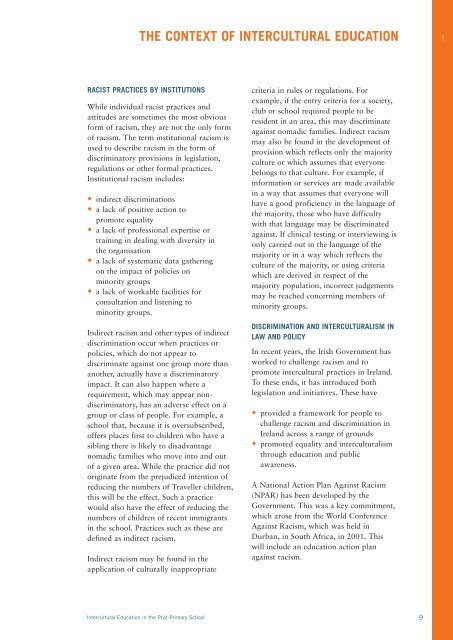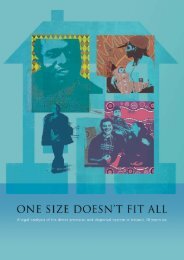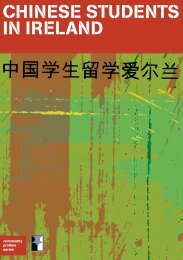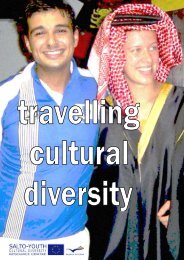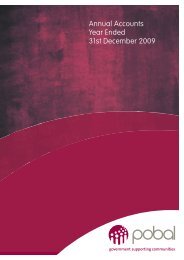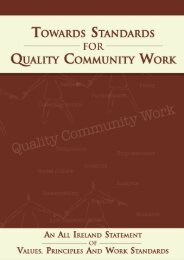Intercultural Education in the Post-Primary School - National Council ...
Intercultural Education in the Post-Primary School - National Council ...
Intercultural Education in the Post-Primary School - National Council ...
You also want an ePaper? Increase the reach of your titles
YUMPU automatically turns print PDFs into web optimized ePapers that Google loves.
THE CONTEXT OF INTERCULTURAL EDUCATION 1RACIST PRACTICES BY INSTITUTIONSWhile <strong>in</strong>dividual racist practices andattitudes are sometimes <strong>the</strong> most obviousform of racism, <strong>the</strong>y are not <strong>the</strong> only formof racism. The term <strong>in</strong>stitutional racism isused to describe racism <strong>in</strong> <strong>the</strong> form ofdiscrim<strong>in</strong>atory provisions <strong>in</strong> legislation,regulations or o<strong>the</strong>r formal practices.Institutional racism <strong>in</strong>cludes:• <strong>in</strong>direct discrim<strong>in</strong>ations• a lack of positive action topromote equality• a lack of professional expertise ortra<strong>in</strong><strong>in</strong>g <strong>in</strong> deal<strong>in</strong>g with diversity <strong>in</strong><strong>the</strong> organisation• a lack of systematic data ga<strong>the</strong>r<strong>in</strong>gon <strong>the</strong> impact of policies onm<strong>in</strong>ority groups• a lack of workable facilities forconsultation and listen<strong>in</strong>g tom<strong>in</strong>ority groups.Indirect racism and o<strong>the</strong>r types of <strong>in</strong>directdiscrim<strong>in</strong>ation occur when practices orpolicies, which do not appear todiscrim<strong>in</strong>ate aga<strong>in</strong>st one group more thanano<strong>the</strong>r, actually have a discrim<strong>in</strong>atoryimpact. It can also happen where arequirement, which may appear nondiscrim<strong>in</strong>atory,has an adverse effect on agroup or class of people. For example, aschool that, because it is oversubscribed,offers places first to children who have asibl<strong>in</strong>g <strong>the</strong>re is likely to disadvantagenomadic families who move <strong>in</strong>to and outof a given area. While <strong>the</strong> practice did notorig<strong>in</strong>ate from <strong>the</strong> prejudiced <strong>in</strong>tention ofreduc<strong>in</strong>g <strong>the</strong> numbers of Traveller children,this will be <strong>the</strong> effect. Such a practicewould also have <strong>the</strong> effect of reduc<strong>in</strong>g <strong>the</strong>numbers of children of recent immigrants<strong>in</strong> <strong>the</strong> school. Practices such as <strong>the</strong>se aredef<strong>in</strong>ed as <strong>in</strong>direct racism.Indirect racism may be found <strong>in</strong> <strong>the</strong>application of culturally <strong>in</strong>appropriatecriteria <strong>in</strong> rules or regulations. Forexample, if <strong>the</strong> entry criteria for a society,club or school required people to beresident <strong>in</strong> an area, this may discrim<strong>in</strong>ateaga<strong>in</strong>st nomadic families. Indirect racismmay also be found <strong>in</strong> <strong>the</strong> development ofprovision which reflects only <strong>the</strong> majorityculture or which assumes that everyonebelongs to that culture. For example, if<strong>in</strong>formation or services are made available<strong>in</strong> a way that assumes that everyone willhave a good proficiency <strong>in</strong> <strong>the</strong> language of<strong>the</strong> majority, those who have difficultywith that language may be discrim<strong>in</strong>atedaga<strong>in</strong>st. If cl<strong>in</strong>ical test<strong>in</strong>g or <strong>in</strong>terview<strong>in</strong>g isonly carried out <strong>in</strong> <strong>the</strong> language of <strong>the</strong>majority or <strong>in</strong> a way which reflects <strong>the</strong>culture of <strong>the</strong> majority, or us<strong>in</strong>g criteriawhich are derived <strong>in</strong> respect of <strong>the</strong>majority population, <strong>in</strong>correct judgementsmay be reached concern<strong>in</strong>g members ofm<strong>in</strong>ority groups.DISCRIMINATION AND INTERCULTURALISM INLAW AND POLICYIn recent years, <strong>the</strong> Irish Government hasworked to challenge racism and topromote <strong>in</strong>tercultural practices <strong>in</strong> Ireland.To <strong>the</strong>se ends, it has <strong>in</strong>troduced bothlegislation and <strong>in</strong>itiatives. These have• provided a framework for people tochallenge racism and discrim<strong>in</strong>ation <strong>in</strong>Ireland across a range of grounds• promoted equality and <strong>in</strong>terculturalismthrough education and publicawareness.A <strong>National</strong> Action Plan Aga<strong>in</strong>st Racism(NPAR) has been developed by <strong>the</strong>Government. This was a key commitment,which arose from <strong>the</strong> World ConferenceAga<strong>in</strong>st Racism, which was held <strong>in</strong>Durban, <strong>in</strong> South Africa, <strong>in</strong> 2001. Thiswill <strong>in</strong>clude an education action planaga<strong>in</strong>st racism.<strong>Intercultural</strong> <strong>Education</strong> <strong>in</strong> <strong>the</strong> <strong>Post</strong>-<strong>Primary</strong> <strong>School</strong> 9


